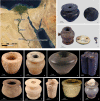Recipes of Ancient Egyptian kohls more diverse than previously thought
- PMID: 35396488
- PMCID: PMC8994005
- DOI: 10.1038/s41598-022-08669-0
Recipes of Ancient Egyptian kohls more diverse than previously thought
Abstract
Kohl, a dark eye cosmetic, is a well-known part of Ancient Egyptian culture. Modern chemical analyses of kohls have largely found lead-based inorganic constituents, whereas earlier studies argued for a much broader range of constituents. Furthermore, organic materials in kohls remain severely understudied. This raises questions regarding the true diversity of materials and recipes used to produce kohls. We analysed the contents of 11 kohl containers from the Petrie Museum collection in London. The objects selected cover a broad range of times and locations in Egypt. Our multi-analytical approach allowed us to characterise both inorganic and organic components. Our data show that inorganic ingredients in kohl recipes are not only lead-based but also manganese- and silicon-based. Our analyses also revealed that organic ingredients derived from both plant and animal sources were commonly used in kohl recipes and sometimes even represent the main constituent. All these findings point towards more varied recipes than initially thought and significantly shift our understanding of Ancient Egyptian kohls.
© 2022. The Author(s).
Conflict of interest statement
The authors declare no competing interests.
Figures




References
-
- Mahmood ZA, et al. Kohl (surma): Retrospect and prospect. Pak. J. Pharm. Sci. 2009;22:107–122. - PubMed
-
- Daar E, et al. X-ray fluorescence analysis of Pb, Fe and Zn in kohl. Results Phys. 2017;7:3590–3595. doi: 10.1016/j.rinp.2017.09.037. - DOI
-
- Scott DA. A review of ancient Egyptian pigments and cosmetics. Stud. Conserv. 2016;61:185–202. doi: 10.1179/2047058414Y.0000000162. - DOI
-
- Ullah PH, Mahmood ZA, Sualeh M, Zoha SMS. Studies on the chemical composition of kohl stone by X-ray diffractometer. Pak. J. Pharm. Sci. 2010;23:48–52. - PubMed
Publication types
MeSH terms
Substances
LinkOut - more resources
Full Text Sources
Medical

